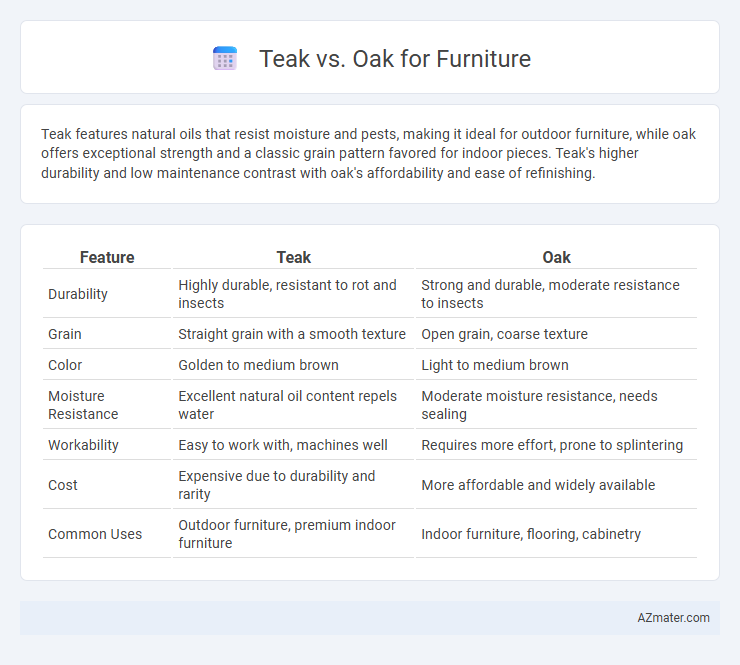Teak features natural oils that resist moisture and pests, making it ideal for outdoor furniture, while oak offers exceptional strength and a classic grain pattern favored for indoor pieces. Teak's higher durability and low maintenance contrast with oak's affordability and ease of refinishing.
Table of Comparison
| Feature | Teak | Oak |
|---|---|---|
| Durability | Highly durable, resistant to rot and insects | Strong and durable, moderate resistance to insects |
| Grain | Straight grain with a smooth texture | Open grain, coarse texture |
| Color | Golden to medium brown | Light to medium brown |
| Moisture Resistance | Excellent natural oil content repels water | Moderate moisture resistance, needs sealing |
| Workability | Easy to work with, machines well | Requires more effort, prone to splintering |
| Cost | Expensive due to durability and rarity | More affordable and widely available |
| Common Uses | Outdoor furniture, premium indoor furniture | Indoor furniture, flooring, cabinetry |
Introduction to Teak and Oak Furniture
Teak furniture is prized for its exceptional durability, natural oils, and resistance to moisture and pests, making it ideal for both indoor and outdoor use. Oak furniture, known for its strength and prominent grain patterns, offers excellent longevity and a classic aesthetic suited for traditional and contemporary styles. Both woods provide unique qualities that influence furniture cost, maintenance, and overall appeal in interior design.
Physical Characteristics: Teak vs Oak
Teak features a dense grain and natural oils that provide exceptional resistance to moisture, pests, and decay, making it ideal for outdoor furniture. Oak exhibits a prominent grain with a hard, durable texture, known for its strength and wear resistance in indoor furniture applications. Both woods are heavy, but teak's high silica content offers superior weather resilience compared to oak's porous structure.
Durability and Longevity Comparison
Teak furniture offers superior durability due to its natural oils that resist water, insects, and rot, making it ideal for outdoor use with an average lifespan exceeding 50 years. Oak, known for its hardness and dense grain, provides excellent strength and resistance to wear, often lasting 30 to 50 years with proper care, primarily suitable for indoor furniture. Both woods maintain structural integrity over time, but teak's high oil content and weather-resistant properties grant it a significant advantage in longevity and low-maintenance requirements.
Resistance to Moisture and Pests
Teak wood exhibits superior resistance to moisture and pests due to its natural oils and dense grain structure, making it ideal for outdoor furniture and humid environments. Oak, while durable and strong, is more susceptible to moisture absorption and insect damage if not properly sealed or treated. Choosing teak over oak ensures longer-lasting furniture with enhanced protection against mold, rot, and termite infestation.
Appearance and Grain Patterns
Teak features a rich golden-brown hue with natural oils that enhance its warm, smooth appearance, while oak presents a lighter, more neutral tone with prominent grain patterns ranging from straight to wavy. The grain in teak is typically straight or interlocked, contributing to a sleek and uniform look, whereas oak's open grain texture creates a more pronounced and rustic aesthetic. Teak's natural luster and subtle grain make it ideal for modern, elegant furniture, contrasting with oak's bold and varied grain that suits traditional and farmhouse-style pieces.
Maintenance Requirements
Teak furniture requires minimal maintenance due to its natural oils that resist water, pests, and decay, making it ideal for outdoor use without frequent sealing. Oak furniture demands regular sealing or finishing to protect against moisture and wear, as its porous structure makes it more susceptible to stains and scratches. Choosing teak reduces the effort and cost of upkeep, while oak provides a classic look that needs consistent care to maintain durability and appearance.
Environmental Impact and Sustainability
Teak furniture is renowned for its durability and natural resistance to pests, sourced mainly from sustainably managed plantations in Southeast Asia that help reduce deforestation pressures. Oak, typically harvested from temperate forests in Europe and North America, offers a renewable option when certified by organizations like FSC that promote responsible forest management. Both woods have relatively low carbon footprints when sourced sustainably, but teak's slow growth can pose longer-term sustainability challenges compared to the faster-regenerating oak species.
Cost and Affordability
Teak furniture commands a higher price due to its exceptional durability, natural oils, and resistance to weather, making it a long-term investment ideal for outdoor use. Oak furniture tends to be more affordable, with widespread availability and a classic appearance suitable for indoor settings, offering excellent value for budget-conscious buyers. Comparing cost, oak delivers affordability and versatility, while teak's premium price reflects superior longevity and minimal maintenance requirements.
Best Uses: Indoor vs Outdoor Furniture
Teak's natural oils and water resistance make it ideal for outdoor furniture, ensuring durability against weather elements and pests. Oak's dense grain and hardness provide excellent stability and wear resistance, making it best suited for indoor furniture such as dining tables and cabinetry. Both woods offer timeless aesthetics, but teak thrives in exposed environments while oak excels in controlled indoor settings.
Which is Better: Teak or Oak for Furniture?
Teak offers superior durability and natural resistance to water, insects, and decay, making it ideal for outdoor furniture exposed to harsh weather. Oak, known for its strength, hardness, and distinctive grain patterns, excels in indoor furniture and provides an elegant, classic appearance with excellent wear resistance. Choosing between teak and oak depends on the intended use, with teak favored for outdoor longevity and oak preferred for indoor aesthetics and robustness.

Infographic: Teak vs Oak for Furniture
 azmater.com
azmater.com